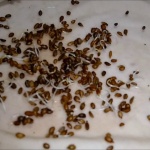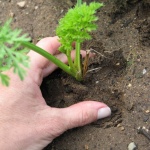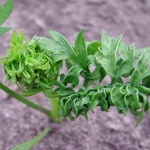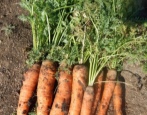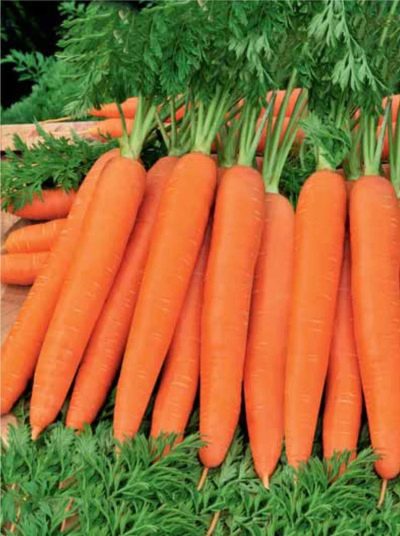
- Name synonyms: Romosa
- Year of approval: 2007
- Appointment: for fresh consumption, for canning
- Leaf rosette shape: semi-spreading
- Leaves: medium to long, green, moderately dissected
- Weight, g: 95-195
- The form : fusiform with slightly pointed tip
- Taste qualities: good and excellent
- Composition : dry matter 9.7-11.3%, total sugar 5.8-8.1%, carotene up to 18.3 mg per 100 g of raw matter
- Ripening terms: mid-season
Romosa is a popular carrot variety that attracts gardeners with its large roots and resistance to transportation.
Breeding history
Carrots were bred by breeders from Holland, who managed to obtain a crop with a high yield and excellent taste characteristics of the fruit. Today the variety is included in the list of available varieties, registered in the State Register, and is actively cultivated in many regions of Russia.
Description of the variety
Romos carrots outwardly practically do not differ from other varieties. It also has medium-sized green tops and orange roots. The peculiarity of the culture is in strong leaf plates of a straight-growing type, which greatly facilitates and speeds up the harvest.
Characteristics of the appearance of the plant and root crops
Initially, carrots form green roots that immediately attract attention on the site. Subsequently, the fruits change color and shape, the main characteristics are:
shape - fusiform, slightly pointed towards the end;
length - up to 24 cm;
weight - from 95 to 195 grams;
the peel is smooth, bright orange.
The advantage of root crops is that they can withstand transportation, do not crack or break.
Purpose and taste of tubers
Romosa delights gardeners with sweet and crunchy root vegetables. The tasters appreciated the taste characteristics. The key feature of Romos carrots is their low calorie content. The nutritional value of one root vegetable is only 35 kcal, while it is rich in useful components and trace elements. 100 grams of carrots contain:
beta-carotene - 18.3 mg;
dry matter - 9.7-11.3%;
sugar - 5.8-8.1%.
Among the useful substances are vitamins of group A and B, as well as minerals: potassium, chlorine, sodium and others.
Carrots are used for the preparation of the first and second courses, as well as for freezing and canning.
Maturation
On average, root crops are formed in 100-127 days. However, when growing crops in the southern regions, the ripening time can be reduced.
Yield
The maximum yield indicator reaches 6.5 kg per m2. If desired, the indicator can be increased if you follow the recommendations for plant care.
Growing and care
To achieve high yields, you must first plant the carrots correctly. Conditions:
when choosing a site, preference should be given to illuminated and calm places;
the soil should be loose, light and fertile;
it is best to plant carrots in low acid soil.
If necessary, the pH value can be lowered independently with the help of alkaline fertilizers, which will act as a neutralizer. The land for planting carrots is prepared in advance, making the necessary fertilizing and loosening the soil.
Landing scheme:
it is better to plant carrots in mid-spring, when the soil warms up enough;
between the rows it is worth retreating 15 cm;
it is necessary to maintain a distance of 5-7 cm between seeds;
planting depth - 2 cm.
After that, you will need to lightly sprinkle the seeds with earth, water abundantly, and cover with foil for a couple of weeks. This will be enough to ensure rapid seed emergence and the formation of the first leaves of the plant. After 14 days, the variety will begin to form a root crop.
Then you should take care of the care of the plant. Here are the highlights.
Thinning. The procedure is necessary if the seeds are planted too thickly. If this is not foreseen, the sprouts will destroy each other.
Watering. Carrots are not very demanding in this regard. It is recommended to water the beds at least once every 2 weeks. During a drought period, the volume of the applied liquid should be increased, and during the rainy season, watering should be stopped altogether. The last time water is introduced into the soil 2 weeks before harvesting. The average watering volume should be 5 liters.
Top dressing. The first time the carrots are fertilized 4 weeks after germination. Then top dressing is applied every 2-3 weeks before harvesting, thus ensuring active growth and formation of root crops. Mineral complexes are more often used as fertilizers, since the plant does not like organic matter. Fertilization with organic compounds will lead to a deterioration in the state of the culture and, in principle, will give absolutely the opposite effect to the desired effect.
Additionally, it is worth taking care of regular weeding to prevent rotting and death of the crop.
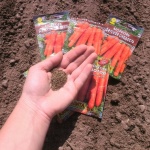
Carrots are one of the most unpretentious crops in terms of growing conditions; they can endure a short drought and a short cold snap. However, to get tasty and large root crops, you should adhere to the basic rules for planting carrots.

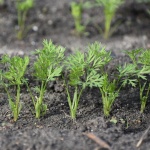
Required climatic conditions
Carrots are usually planted in the warm season, when the risk of frost return is minimal. The average air temperature should rise to 15 degrees, and the ground - up to 10 degrees Celsius. Typically, these temperatures occur in late April or early May.
Disease and pest resistance
Romosa is distinguished by its increased resistance to diseases and pests. However, this does not mean that the plant is not capable of getting sick. To prevent the death of the culture, it is worth taking care of preventive treatments of carrots with special formulations. And also before sowing, you can soak the seeds in a solution of potassium permanganate to strengthen the immunity of the variety.

Carrots grow in almost any garden. There is an opinion that this culture is very resistant to all kinds of diseases and pests, but this is not the case. Without proper care, carrots become susceptible to all kinds of infections and are affected by harmful insects.


